| dc.description.abstract | The classical approach to gene discovery has been to culture micro-organisms demonstrating a specific enzyme activity and then to recover the gene of interest through shotgun cloning. The realization that these standard microbiological methods provide limited access to the true microbial biodiversity and therefore the available microbial genetic diversity (collectively termed the Metagenome) has resulted in the development of environmental nucleic acid extraction technologies designed to access this wealth of genetic information, thereby avoiding the limitations of culture dependent genetic exploitation. In this work several gene discovery technologies was employed in an attempt to recover novel bacterial laccase genes (EC 1.10.3.2), a group of enzymes in which considerable biotechnological interest has been expressed. Metagenomic DNA extracted from two organic rich environmental samples was used as the source material for the construction of two genomic DNA libraries. The small insert plasmid based library derived from compost DNA consisted of approximately 106 clones at an average
insert size of 2.7Kbp, equivalent to 2.6 Gbp of cloned environmental DNA. A Fosmid based large insert library derived from grape waste DNA consisted of approximately
44000 cfu at an average insert size of 25Kbp (1.1 Gbp cloned DNA). Both libraries were screened for laccase activity but failed to produce novel laccase genes. As an alternative approach, a multicopper oxidase specific PCR detection assay was developed using a laccase positive Streptomyces strain as a model organism. The newly designed primers were used to detect the presence of bacterial multicopper oxidases in environmental samples. This resulted in the identification of nine novel gene fragments showing identity ranging from 37 to 94% to published putative bacterial multicopper oxidase gene sequences. Three clones pMCO6, pMCO8 and pMCO9 were significantly smaller than those typically reported for bacterial laccases and were assigned to a recently described clade of Streptomyces bacterial multicopper oxidases.
Two PCR based techniques were employed to attempt the recovery of flanking regions for two of these genes (pMCO7 and pMCO8). The use of TAIL-PCR resulted in the recovery of 90% of the pMCO7 ORF. As an alternative approach the Vectorette™ system was employed to recover the 3’ downstream region of pMCO8. The complexity of the DNA sample proved to be a considerable technical challenge for the
implementation of both these techniques. The feasibility of both these approaches were however demonstrated in principle. Finally, in an attempt to expedite the recovery of fulllength copies of these genes a subtractive hybridization magnetic bead capture technique was adapted and employed to recover a full – length putative multicopper oxidase gene from a Streptomyces strain in a proof of concept experiment. The StrepA06pMCO gene fragment was used as a ‘driver’ against fragmented Streptomyces genomic DNA (‘tester’) and resulted in the recovery of a 1215 bp open reading frame.
Unexpectedly, this ORF showed only 80% identity to the StrepA06pMCO gene sequence at nucleotide level, and 48% amino acid identity to a putative mco gene derived from a Norcardioides sp JS614. | en_US |

